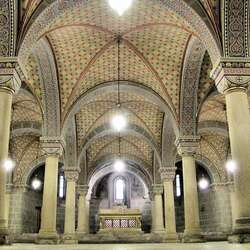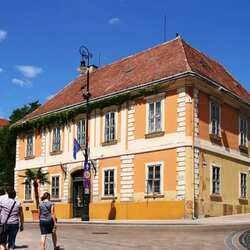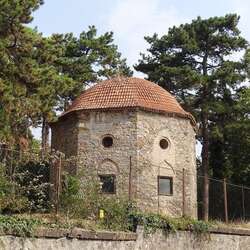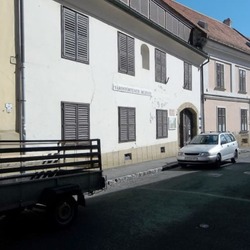Bishop's Palace in Pecs
The Bishop's Palace in Peche is called one of the most notable historical and architectural monuments. The city is located in the south-west of Hungary, at the foot of the Mecek Mountain. Less than 150,000 people live here. Despite the small population, there are so many attractions in the city that in 2010 it was recognized as the cultural capital of Europe.
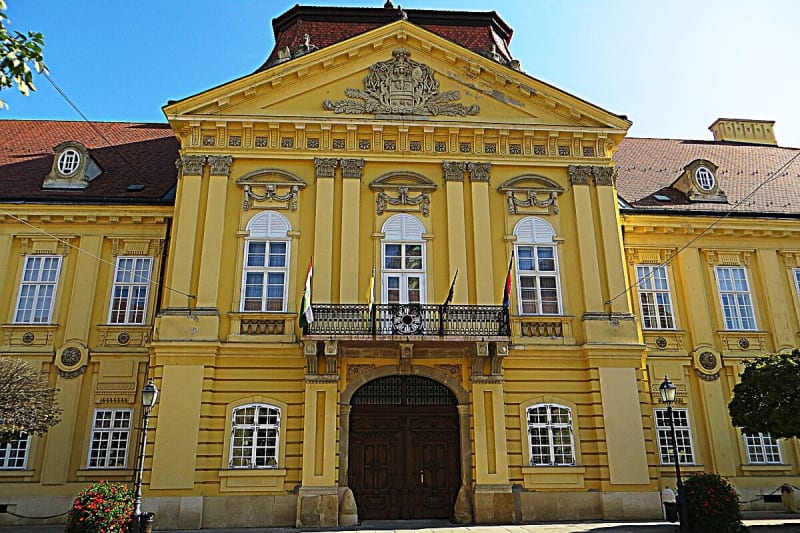
The appearance of the bishopric in Peche
Before proceeding to the description of the Bishop's Palace in Peche, let's tell you a little bit from history. The Christian religion in the territory of the former Roman province has been actively developing since the 4th century AD. Evidence of this is the cemeteries of Christians that have survived to the present day. In the early Middle Ages, the territory changed hands, and in the 10th century it came under the rule of the Holy Roman Empire.
Since 1009, the city of Pec has been an important administrative center in Hungary and a bishop's residence. A bishop is a spiritual rank, one of the most honorable in the Catholic Church, which is usually assigned to the head of an independent territorial unit of church government - a diocese. It is believed that every Catholic bishop is the successor of the apostles.
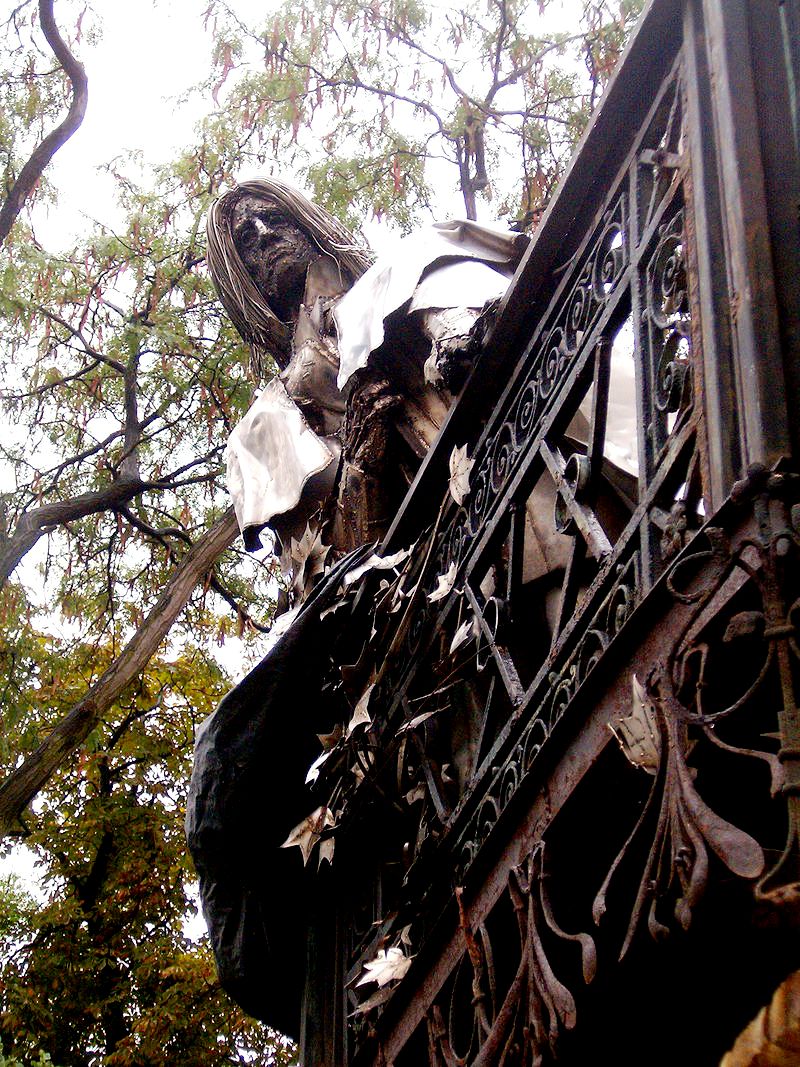
The appearance of the episcopal see in medieval Peche is associated with the Hungarian King Stephen I the Saint. According to the chronicles, a Christian church had been operating on the main square of the city for almost 150 years in the 11th century. When it burned down, a stone basilica in the Romanesque style was erected in its place. Gradually, new urban structures were created near the cathedral, including a residence where a high church official was to live. One of the first clergy to live here was the Frankish Bishop Bonipert, the second was the Hungarian Bishop Mohr, and later many historical figures, including those from the Habsburg dynasty, found shelter in the palace.
Construction and architecture of the palace
The first version of the Bishop's Palace in Peche was built in the Romanesque style back in the 12th century, the main function of any architectural structure in that turbulent time was defense, subsequently the building was rebuilt and updated more than once.
In the XV-XVI centuries, the Bishop's Palace in Peche was remodeled in the Renaissance style. In 1751-1770, Bishop Gyorgy Klimo once again changed the appearance of the building. The facade was decorated in the Baroque style. A second floor was added to the north and east wings, and the south wing was extended.
In the period from 1838 to 1852, the eastern facade was decorated in the Neo-Renaissance style. The facade facing the Dome Square is decorated with wooden columns and power projections. It is said that the famous Hungarian composer Franz Liszt visited the Bishop's Palace in Pec. Being very impressed by the architecture of the building, the musician promised to write a festive mass for the Cathedral of the city. This is how an amazing sounding religious piece of music was written. In 1983, the sculptor Imre Varga created a sculpture of the composer. The Leaf on the balcony seems to be listening to the bells on the Dome Square.
The Bishop's Palace in Peche welcomes visitors on Thursdays during the summer months. Guests can visit the lobby, the waiting room, the library, the dining room, the private chapel, the rooms of the Habsburgs.
The Bishop's Palace in Peche is called one of the most notable historical and architectural monuments. The city is located in the south-west of Hungary, at the foot of the Mecek Mountain. Less than 150,000 people live here. Despite the small population, there are so many attractions in the city that in 2010 it was recognized as the cultural capital of Europe.

The appearance of the bishopric in Peche
Before proceeding to the description of the Bishop's Palace in Peche, let's tell you a little bit from history. The Christian religion in the territory of the former Roman province has been actively developing since the 4th century AD. Evidence of this is the cemeteries of Christians that have survived to the present day. In the early Middle Ages, the territory changed hands, and in the 10th century it came under the rule of the Holy Roman Empire.
Since 1009, the city of Pec has been an important administrative center in Hungary and a bishop's residence. A bishop is a spiritual rank, one of the most honorable in the Catholic Church, which is usually assigned to the head of an independent territorial unit of church administration - a diocese. It is believed that every Catholic bishop is the successor of the apostles.
The appearance of the episcopal see in medieval Peche is associated with the Hungarian King Stephen I the Saint. According to the chronicles, a Christian church had been operating in the main square of the city for almost 150 years in the 11th century. When it burned down, a stone basilica in the Romanesque style was erected in its place. Gradually, new urban structures were created near the cathedral, including a residence where a high church official was to live. One of the first clergy to live here was the Frankish Bishop Bonipert, the second was the Hungarian Bishop Mohr, and later many historical figures, including those from the Habsburg dynasty, found shelter in the palace.
Construction and architecture of the palace
The first version of the Bishop's Palace in Peche was built in the Romanesque style back in the 12th century, the main function of any architectural structure in that turbulent time was defense, subsequently the building was rebuilt and updated more than once.
In the XV-XVI centuries, the Bishop's Palace in Peche was remodeled in the Renaissance style. In 1751-1770, Bishop Gyorgy Klimo once again changed the appearance of the building. The facade was decorated in the Baroque style. A second floor was added to the north and east wings, and the south wing was extended.
In the period from 1838 to 1852, the eastern facade was decorated in the Neo-Renaissance style. The facade facing the Dome Square is decorated with wooden columns and power projections. It is said that the famous Hungarian composer Franz Liszt visited the Bishop's Palace in Pec. Being greatly impressed by the architecture of the building, the musician promised to write a festive mass for the Cathedral of the city. This is how an amazing sounding religious piece of music was written. In 1983, the sculptor Imre Varga created a sculpture of the composer. The Leaf on the balcony seems to be listening to the bells on the Dome Square.
The Bishop's Palace in Peche welcomes visitors on Thursdays during the summer months. Guests can visit the lobby, the waiting room, the library, the dining room, the private chapel, the rooms of the Habsburgs.


